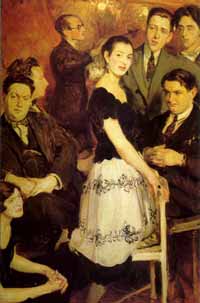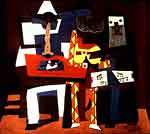 Les Six "The indifference of the public is what's depressing. Enthusiasm, or vehement protest, shows that your work really lives." - Darius Milhaud
Three weeks after the premiere of Parade, Blaise Cendrars organized an evening of poetry and music in honor of the ballet, attended by artists and musicians who rallied around Satie, forming the group Les Nouveaux Jeunes, and marking the emergence of a new musical avant-garde. Les Nouveaux Jeunes' lineup would change somewhat, and finally crystallize with Darius Milhaud, Francis Poulenc, Arthur Honegger, Louis Durey, Germaine Tailleferre, and Georges Auric. With Erik Satie as spiritual father, and Jean Cocteau as spokesman, the group was christened "Les Six" by critic Henri Collet, after the Russian "Mighty Five." With this identifying label, and a recognizable aesthetic of simplicity, the composers who had been writing privately for years were able to gain attention from the public as a force.
Despite the elements the six composers had in common, there differences were far greater, and by the 1920s each was pursuing solo careers on their own. Today, we best remember Darius Milhaud, Francis Poulenc, and Arthur Honegger. Few pieces by the other three are performed.
A major early modern influence on French music, Honegger was one of
Les Six's founding members. Ironically, Honegger was probably the most "Germanically" influenced of the members of the group, in stated contrast
to the original aesthetic ideal as set by Cocteau. He also devoted more
time to "serious study" than most of his contemporaries. In time, Honegger
rejected Satie, and strove after high seriousness in a way alien to
the rest of the group. While most members primarily produced short,
jewel-like pieces, Honegger was the symphonist.
Like Satie, Francis Poulenc held a strong opposition to the excessive
sensitiveness and refinement of French Impressionism. His works were
marked by this plain statement and frankness of thought, especially
in early works. Poulenc was the finest choral composer of the group
and is still praised for his spontaneous melodic invention and originality.
Darius Milhaud, like the other members of Les Six, joined
the group somewhat unwittingly, being taken in before he really knew
what was going on. Unimpressed by Cocteau's "hands-on" approach to Les
Six as aesthetics were involved, he nevertheless collaborated with both
Satie and Cocteau in various projects, including his famous ballet "Le
Boeuf sur le toit." He was known for his atonality; the composer Charles-Marie
Widor once said, "The worst of [Milhaud's dissonances] is that you get
used to them!" Louis Durey (18881979) Louis Durey joined Les Six by accident, it seems, little
aware that the artistic group he was joining were in fact creating a
music association based on little more than friendship. He, too, collaborated
with Jean Cocteau on a piece (as Satie had done years earlier), with
his "Scenes de Cirque." Before long, however, he felt that Cocteau's
influence was artistically compromising, and did not seek collaboration
again. Georges Auric (1899-1983) "Enough of clouds, waves, aquariums, water-sprites and nocturnal scents; what we need is a music of the earth, everyday music . . . music one can live in like a house." - Jean Cocteau
Georges Auric came to Les Six as a student of Satie. Together with
Honegger and Durey he was one of the founding members of the group,
but his music had more in common with that of Poulenc, his contemporary,
than that of Honegger and Durey, his seniors. Together with Poulenc
and Milhaud, Auric most exemplified the ideals put forth by Cocteau.
As one critic noted, "with these three we penetrate more closely into
the heart of the artichoke . . . they have the bite, the courage, the
brutality."
Music of Les Six: This Classical.Net site gives a detailed review of Les Maris de la Tour Eiffel, the closest thing to a collective work performed by Les Six. A Poulenc Biography: This straightforward biography offers a brief look at Poulenc's relationship with Les Six before going into greater depth about his composing career. Opera: A Philatelic History: Brief information about the members of Les Six, accompanied by images of postage stamps bearing their portraits. Arthur
Honegger Biography: Without going into great depth of detail, this
biography offers an introduction to the man and his work.
|
MPR Home | News | Music Collection | Events | Radio Listening | Your Voice | About Us | Support Us | Help ©2005 Minnesota Public Radio | Terms of Use | Privacy Policy |



